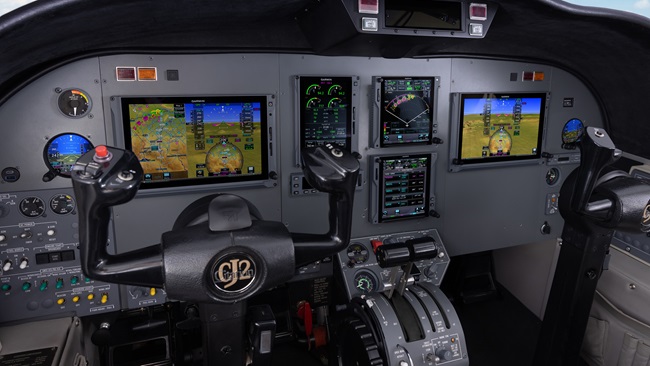Eric Rush was flying his familiar route to work one morning last spring, crossing a ridge where he’d never seen traffic before, when it happened. “There’s no traffic displaying ahead of me on the iPad—nothing at all—and all of a sudden, there’s an airplane right in front of me,” he said.
He was about eight miles southeast of Carlisle, Pennsylvania, flying his 1979 Piper Archer II to AOPA’s headquarters in Frederick, Maryland. “I had known that there were limitations to the traffic,” said Rush, manager of enterprise architecture in AOPA’s Information and Technology department, who was testing hardware and software for receiving ADS-B data. Which hardware and software are not relevant to his experience, because the limitations apply equally to all.
Despite that knowledge, his initial reaction was disbelief. “It makes you wonder—do I have this connected correctly? Is there something wrong with this device?”
Rush said the airplane’s crossing half a mile in front of him did not compromise safety. “It was a [Cessna] 182, and I could see the people in it,” he recalled. “I’m pretty sure he saw me.”
After that experience, however, Rush delved into portable ADS-B traffic receivers, talking with software and hardware manufacturers, “and just a ton of reading—intricate reading.”
As a result, he’s become an evangelist of sorts, speaking about the topic at aviation events large and small. “There is a ton of confusion. Realize that unless there’s an airplane with ADS-B Out around, you won’t see any traffic. I still see this today, firsthand. If people see nothing, I’m concerned they’re going to become overconfident.”
ADS-B is Automatic Dependent Surveillance-Broadcast, and there are two types. ADS-B Out—which the FAA has mandated beginning January 1, 2020, in most airspace where a transponder is required today—broadcasts a WAAS-enhanced GPS position to ground stations and other aircraft; eventually, the FAA will use this data for aircraft separation. ADS-B In, which is optional, transmits weather and traffic information into the cockpit, where it can be displayed on panel-mounted avionics or a tablet like the iPad. Portable ADS-B In receivers are becoming popular, but if they’re used in an aircraft that does not yet broadcast an ADS-B Out signal, traffic information displayed will be incomplete.
Assumes operation in airspace with ADS-B ground network coverage. If you have a dual-channel portable ADS-B receiver, which receives both the 978-MHz Universal Access Transceiver and 1090ES datalinks, you will see aircraft broadcasting “air to air” via Mode S—even if there is not an ADS-B Out aircraft near you. Think of 978-MHz UAT as “air to ground;” there is no traffic data unless an ADS-B Out aircraft requests it from a ground station. “You will see more traffic with a dual-channel receiver than without,” AOPA’s Eric Rush said. “The question is whether it’s relevant traffic.” Dual-channel receivers include the Freeflight RANGR-RX, Garmin GDL 39, Sagetech Clarity, SkyGuard TWX, SkyRadar-D, and Stratus 2.
That’s because ADS-B traffic information is not continually broadcast to airborne receivers, like weather information is. Traffic is broadcast when an airplane reports its position using ADS-B Out—the certified datalink that will be required in most controlled airspace beginning January 1, 2020. When traffic is broadcast, it is tailored to the requesting aircraft’s position, and includes tracked aircraft within its “puck,” a 15-nm circle around the aircraft’s position, extending 3,500 feet above and below.
Rush calls it a puck because the shape is like that of a hockey puck. “Always remember, it’s his hockey puck.” Another aircraft caused traffic to be displayed on Rush’s tablet that morning, but not the Cessna that passed in front of him—its position was too far from the ADS-B Out-equipped airplane to be broadcast as a relevant target, even though it was close to Rush’s Piper.
What’s the future of these portable receivers after ADS-B is mandated on January 1, 2020? They can serve as your ADS-B In traffic solution, Rush notes—and when you add ADS-B Out, your portable will give you all available traffic information. (You may not see aircraft in nonradar areas, where ADS-B is not required, or aircraft without electrical systems.)
“Portables do not comply with the 2020 mandate,” he stresses. Portable receivers are not certified, but ADS-B Out equipment must be, so the data can be used by air traffic control for traffic separation.
Rush plans to continue using his portable to display ADS-B In information after he equips his airplane for ADS-B Out. And he’s still using it today, before he equips. “I personally think you’re safer with the device than without it, so long as you understand the limitations,” he said. “It’s a second set of eyes.”
Email [email protected]
Who can you see?
If you have: ADS-B Out and In
If you have: ADS-B In only, and there are no ADS-B Out aircraft nearby
If you have: ADS-B In only, and are within reception range of a ground tower being triggered by an aircraft with ADS-B Out
You will see: All aircraft with an active Mode C or Mode S transponder, within a 15-nm radius and within 3,500 feet of your altitude.
You will see: No traffic information. (If you have a dual-channel ADS-B receiver, you may see aircraft reporting their position with ADS-B Out via 1090ES (extended squitter) broadcast—possibly some distance away.)
You will see: Positions of aircraft within the “hockey puck” (15-nm radius, 3,500 feet above and below) of any ADS-B Out aircraft triggering broadcasts. This traffic may not be anywhere near you.



